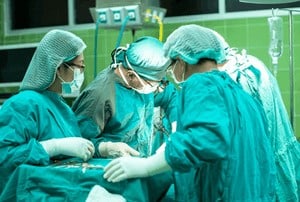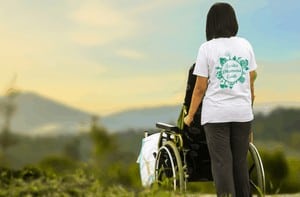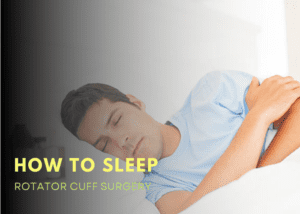We hope you love the product we recommend! Just so you know, at no extra cost to you, we may get a small commission for purchases made through links in this post. Your support is appreciated. Enjoy the read!
Have you ever woken up with your back aching, limiting the movement of your body throughout the day?
Well, the Oxford dictionary defines a disability as
“A physical or mental condition that limits a person’s movements, senses, or activities.”
Yes, that backache is currently disabling, but we both know it’s not a disability.
So, is scoliosis a disability?
Keep reading to find out!
What is Scoliosis?
It’s where a person’s spine has an abnormal, sideways curve of 10 degrees or more.
And scoliosis is a pretty common medical condition that affects 2-3% of the US population.
That’s about 6 to 9 million people!
If you’re looking at someone who has it, depending on how severe it is, you may or may not even be able to tell.

Symptoms of Scoliosis
Some symptoms may be super obvious while some are more subtle and difficult to point out.
- A visibly curved spine
- Uneven shoulders
- Leaning the entire body to one side
- Uneven waist
- One hip higher than the other
- Ribs sticking out on one side
- Clothes not fitting right
Typical pain that comes with scoliosis includes:
- Headaches
- Neck Pain
- Shoulder Pain
- Hip Pain
If you think you may have scoliosis, you can do this simple test at home.
Adam’s Test
How to test:
- Take off shirt so the spine is visible
- Put your feet together
- Bend forward at the waist until your back is horizontal
- Put your palms together with your arms hanging down
If your shoulder blades slant, you should probably see your doctor.
Watch this video for a guided tutorial on how to perform the Adam’s test.
Mild to Severe Scoliosis
A spinal curve between 10 and 20 degrees is considered mild scoliosis.
It’s most common in premenstrual girls, but is also seen in boys and adults.
Mild scoliosis can go undiagnosed for years since the changes in posture are small.
Here are the subtle signs to look out for:
- Curve between 10-20 degrees
- May or may not experience pain
- Body tilts to one side
- Head tilt
- Uneven leg lengths
- One shoulder sits higher than the other
- One shoulder blade sticks out more than the other
- One hip appears higher than the other
- Head is pushed forward and ears aren’t aligned with the shoulders
According to some scoliosis experts, mild scoliosis has a 22% chance of progressing.
Once the curvature gets larger than 20 degrees, that risk jumps to 68%!
Teens in puberty may experience an extreme progression to their scoliosis because of hormonal changes and growth spurts.
If you suspect your child has scoliosis, don’t hesitate to take them to your doctor to get checked.
Moderate Scoliosis
When the curve of your spine reaches 25-40 degrees, it’s considered moderate.
The symptoms of moderate scoliosis are the same, but more noticeable and extreme:
- The rotation of the spine may be more evident
- Ribs and shoulders will noticeably stick out
- Shoulders will be uneven
Severe Scoliosis
Your spine will curve the most. Severe scoliosis measures over 40 degrees.
Adolescents curve at 40-45 degrees, while adults curve in the range of 50-55 degrees.
It can be disabling. It could be difficult for your lungs to function properly and give you heart problems.
Some symptoms are:
- Being winded easily with physical activity
- Fatigued after sitting or standing for long periods of time
- Impaired respiratory function
- Pneumonia
Functional vs. Structural Scoliosis
In about 80% of scoliosis is idiopathic, which means the cause is unknown.
What experts have found is that this disorder tends to be hereditary. So, if one of your parents or grandparents have it, you may be at risk for it too.
There are two categories: functional and structural.
What’s the difference?
Keep reading!
Structural Scoliosis
A fixed curve of your spine and considered more serious because it doesn’t straighten out on its own.
- The most common category
- Can’t be reversed without surgery
- Spinal rotation – a spinal movement in which you turn the spinal column around itself, usually favoring one side
- Side-to-side curvature of the spine
Common causes include:
- Cerebral palsy or muscular dystrophy
- Birth defects affecting the development of the bones of the spine
- Injuries to or infections to the spine
- Tumors
- Down syndrome
- Marfan syndrome – a disorder of the connective tissue. People with marfan syndrome tend to be tall and thin, have long legs, arms, fingers and toes, and flexible joints.
Functional (Nonstructural) Scoliosis
Your spinal structure is normal and there is no spinal rotation.
- The spine works normally but looks curved
- A temporary change in spinal curvature
- Caused by an underlying problem
Causes:
- Different leg lengths
- Muscle spasms
- Inflammatory conditions, like Appendicitis and Pneumonia
If you can figure out and fix what the underlying problem is, you can get rid of your scoliosis without any treatment!
Can You Claim Social Security Disability for Scoliosis?
The Americans with Disabilities Act defines disability as a person who:
- Has a physical or mental impairment that substantially limits one or more major life activities
- Has a record of such an impairment, or
- is regarded as having such an impairment
According to disability experts at Disability Benefits Help, if you’ve been medically diagnosed with scoliosis and it’s bad enough that you are physically unable to work, you may be eligible for Social Security Disability benefits.
Note that scoliosis is a curvature of the spine that can range from mild to severe, and is not a disease.
Can I Prevent Scoliosis?
Despite what you may have heard, you can’t give yourself scoliosis.
Nor can you prevent it.
Maybe you’re concerned with your kids’ heavy backpacks they carry around at school.
This may give them back or neck pain, but it not scoliosis.
Bad posture is another one many people associate with this condition.
Again, it may cause pain or discomfort,but won’t give you scoliosis.
However, if you or your child already have scoliosis, you can prevent progression.
There are many daily exercises you can do to help with that.
Here’s an easy one:
- Stand up straight with a small weight (1lb~) in your left hand. Feet shoulder-width apart.
- Lean to the left side without bending your knees
- Hold for 3 seconds before coming back up
- Do 5 reps and repeat on the right side.
Easy, right? Increase the reps and the weight gradually as you get stronger.
Untreated Scoliosis
We know that mild cases of scoliosis don’t usually need treatment.
So what happens if you or your child’s moderate to severe scoliosis goes untreated?
The scoliosis curve will most likely progress.
Treatment doesn’t need to be as severe as surgery and usually isn’t necessary anyway.
Here’s what to expect if you don’t treat your scoliosis:
- Spinal curve may increase
- Deformity may occur
- Increased pain
- Breathing problems with a more severe curve
Scoliosis in Children
Typically presents itself in adolescents but can start earlier in childhood and infancy.
Early detection in adolescents is crucial to reduce your child’s curve progression.
Paul Sponseller, M.D., a pediatric orthopaedic expert and director of the Johns Hopkins Division of Pediatric Orthopaedic Surgery says,
“If scoliosis can be diagnosed before the child has a growth spurt, the [physician] can determine a treatment plan that prevents a bigger curve from forming during times of growth.”
Infantile Idiopathic Scoliosis
Don’t be alarmed!
This is a rare form of scoliosis (accounts for less than 1% of idiopathic scoliosis) that affects children ages 3 and under.
- Most infants that develop abnormal curves do so in their first six months
- Children who develop scoliosis before the age of 5 are more likely to have cardiopulmonary abnormalities – a range of serious disorders that affect the heart and lungs
- Infants with idiopathic scoliosis don’t usually experience any pain from it
Most infants with this condition have a mild curve (10-25 degrees) that rarely gets worse and usually corrects itself.
Actually, about 80% of scoliosis in infants will resolve without treatment.
These cases only need to be treated with observation by:
- Regular visits to an orthopedic surgeon
- Physical exams and X-rays to watch the curve
Juvenile Idiopathic Scoliosis
Spinal curves diagnosed between ages 3-10 fall under this category.
Juvenile scoliosis only makes up about 1/5th of the cases but has the highest chance of getting worse.
Don’t let that scare you, there are simple solutions.
If your child’s curve is mild to moderate, bracing is usually suggested.
Bracing is a non-surgical treatment to prevent the curve from worsening and has fantastic results.
It’s usually suggested for kids with an angle of:
- at least 25 degrees in their spine and still growing
- less than 25 degrees but has gotten at least 5 degrees worse during the follow up appointments
The goal of bracing is to avoid a major surgery by stopping curve progression. More specifically, to prevent it from reaching 40 or 50 degrees at skeletal maturity
A study found that 75% of teens who wore a brace
“significantly decreased the progression of high-risk curves to the threshold for surgery.”
However, if the curve gets worse while they grow, they may need more aggressive treatment or surgery.
Adolescent Idiopathic Scoliosis
Diagnosed between the ages of 10-18 years old and makes up about 80% of the cases.
If your child is diagnosed with Adolescent Idiopathic Scoliosis (AIS), they’ll be assessed with:
- The Adams test, to help better understand the amount of torso asymmetry
- Ligament laxity (chronic body pain characterized by loose ligaments) for connective tissue disorders
- Neurological exam
- Imaging evaluation
- X-rays
Scoliosis in Adults
Adult scoliosis is also known as adult deformity and is:
- Any scoliosis that is newly found in adults (18 years or older), or
- Patients with AIS who have reached skeletal maturity (finished growing)
While we know that scoliosis can be hereditary, the main causes of adult deformity are:
- Aging
- Natural wear-and-tear, or
- degenerative arthritis that occurs within the joints of the spine
The most common symptoms are:
- Pain in the legs
- Pain in the lower back
When is Scoliosis Surgery Necessary?
Surgery is a pretty big, life-altering event.
It’s best to talk to your doctor about other options you can explore first like:
- Physical therapy
- Chiropractic care
- Epidural or nerve blocking injections
- Acupuncture
- Massage therapy
- Posture therapy
- Yoga
- Exercises to strengthen the abdominal muscles and back
- Braces for short-term pain relief
Adult Scoliosis Surgery
One orthopedic surgeon says,
“Only a small percentage of patients with adult scoliosis will ever need surgery…[it’s] most likely not the best option for more than 90 percent of [cases].”
Surgery is suggested if your curve is greater than 45-50 degrees because the curve can start affecting your lungs.
If you’re considering surgery keep these things in mind:
- Surgery is the right option for only a small amount of people
- Make sure you fully understand the surgeries and possible complications
- Choose an experienced medical team you trust
Scoliosis Surgery for Children
In most cases, your child won’t need surgery.
Surgery isn’t recommended for any children who still have some growing to do.
Observation and bracing are the first treatment options when managing adolescent scoliosis.
If your child has a mild to moderate spinal curve (10-30 degrees), it most likely won’t get any worse.
Your child should wear a brace for 22-23 hours of the day to lessen the curve and prevent it from getting worse
Surgery is only recommended as a last resort if the curve is severe (45-50+ degrees) and you’ve tried everything else.
What is the Cost of Scoliosis Surgery?
The cost varies depending on the type of insurance you have and which state you’re in.
One thing is for sure, it’s expensive.
The most recent (2011) average cost for adult surgeries with a hospital stay of 5.6 days is $67,400.
Don’t forget about post-surgery costs:
- Pain medication
- Physical Therapy
- Maybe a cane

Scoliosis Surgery Recovery
After waking up from the surgery, you’ll need to stay in the hospital for 4-7 days to be monitored and recover.
Day 1: You’ll still have monitors and intravenous (IV) lines hooked up to you.
Day 2: IV tubes and drains will be removed.
Day 3: Narcotic pain medication can be taken orally instead of through IV’s.
Day 4-7: Depending on how your body responds to medication and recovery, you may get discharged on day four. Or you might be asked to stay longer to monitor your healing.
What to Expect after Surgery
Everyone responds to surgery differently, so you may:
- be hesitant about attempting to get out of bed
- take a couple of days before you feel confident walking
- need help in and out of bed
- be in pain, feel tired or dizzy
- not want to eat or drink for a few days
SAVVY TIP:
It’s important to get up and move around to strengthen your back and regain flexibility.
Ready to Go Home?
Before you’re given the “OK” to leave the hospital you should be able to:
- Get in and out of bed without help
- Be able to walk the hallways with small steps
- Eat solid food
- Show no sign of infection
You’ll need a friend or family member to drive you home, since you (obviously) won’t be able to drive.

What to Expect When Back at Home
You’ll most likely need help with even the most simple tasks.
For example, swallow your pride and let your spouse brush your hair!
Here is a list of “no-no’s” during your healing process:
- No bending – You can bend at the knees and hips but NOT the back
- No twisting
- This one will be a little bit more tricky to avoid. We normally twist ourselves to get in and out of bed.
- Try the “log roll” technique instead. (Keeping your back straight and knees bent together while rolling into bed without twisting or bending the spine.)
- No lifting – Don’t lift anything heavier than 8lbs.
- No driving – Sorry supermom and dad, someone else will have to drive you around. Think of them as being your personal chauffeur.
Scoliosis Resources
1. Curvy Girls Scoliosis
Your daughter doesn’t need to feel like she’s alone.
Feeling alone and different because she had to wear a scoliosis brace as a teen, Leah Stoltz founded this group called Curvy Girls Scoliosis.
It’s a safe space for other girls to come together and talk about their experiences.
In the group meetings, they talk about:
- how to tell others about their scoliosis
- how to layer and dress to cover their brace
- how to tell their doctors how they feel
- Regular teenage stuff to support each other
The Curvy Girl’s community is peer-led and their mission is to reduce the emotional impact of scoliosis. They empower girls through education, mutual support and acceptance to:
- Become leaders
- Make healthy lifestyle choices
- Improve self-esteem
There are many events happening every week throughout the year across the US that you both can benefit from.

2. National Scoliosis Center
Since 2015, this facility opened their doors to help people with scoliosis.
The National Scoliosis Center is the only one in the states that’s 100% dedicated to the study and treatment of scoliosis.
Based in Fairfax, VA with a satellite office in Baltimore, MD, you’ll find custom-made braces and specially trained orthotists to help you manage your scoliosis.
Since they offer full-service at their locations, you won’t need to bounce around to different doctors.
Dealing with scoliosis is stressful enough without being sent to see different specialists, so you can ease your mind and put everything in their trusted hands.
3. Usain Bolt Scoliosis
You know the Olympic world record holder for the 100 meter, 200 meter, and 4 x 100 meter relay?
Yes, Usain Bolt AKA ‘Lightning Bolt’.
Why do I bring him up?
He has scoliosis.
I’m telling you that a 5-time Olympic gold medalist not only lives with scoliosis but COMPETES with it.
He was diagnosed with scoliosis as a child and told ESPN that at the time “it wasn’t really a problem.”
But over the years it got worse and became more “S” shaped.
His scoliosis is now classified as adult idiopathic.
He says as long as he keeps his core and back strong, scoliosis doesn’t really bother him.
He’s never had any surgery and just continues to run with his dreams. What a great inspiration to us all!
Final Thoughts
We hope we answered your question of “is scoliosis a disability?”
Depending on the severity of your scoliosis, it can be disabling. But in most cases, it’s not as scary as it sounds.
Remember, 80% of infants’ scoliosis fixes itself without treatment, 75% of children with scoliosis have successful results with bracing, and 90% of adult cases don’t need surgery.
You can still live your best life and manage your scoliosis along the way.
I mean, if Usain Bolt can push through his scoliosis and achieve his dreams, so can you!!
**Keep learning about your body, your brain and how to get better sleep here!**
> Want to sleep better at night? Find out which best mattress for scoliosis we recommend! <<






